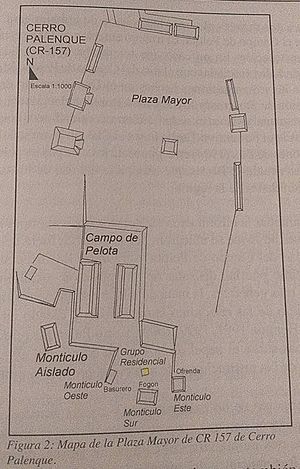Cerro Palenque facts for kids
Cerro Palenque is an ancient city site in Cortés, Honduras. It was built on a hill overlooking rivers. This city started small around 500 to 800 AD. It grew much bigger between 850 and 1100 AD, with over 500 buildings.
Archaeologists don't know what the people of Cerro Palenque called themselves. This is because, unlike the Maya, they didn't leave any writing. Experts have tried to guess who they were. Some ideas include the Tol, Lenca, or Maya people. But we still don't know for sure.
Contents
Where is Cerro Palenque?
The site is on top of a hill called Cerro Palenque. It's about 232 meters (760 feet) above sea level. You can find it near the town of Santiago. This area is where the Ulua, Humuya, and Blanco rivers meet. It's also close to other hilltops to the north. The site is about 40 kilometers (25 miles) from the city of San Pedro Sula in Honduras.
The first part of the city was built on Cerro Palenque hill. This happened during the Late Classic period (500 to 800 AD). It was a small but impressive settlement. Later, in the Terminal Classic period (850-1100 AD), the city moved. It grew onto lower hills north of Cerro Palenque. At this time, it became the biggest city in the lower Ulua river valley.
Why was this location important?
Cerro Palenque was in a very good spot. Major rivers flow into the valley from the south and southwest here. This meant the city could control trade. It connected goods from the inside of the country to the coast. It also traded with places like Belize and Yucatan.
The Maya people of Yucatan told the Spanish that the Ulua River valley was rich. It was known for feathers and honey. They also really liked its chocolate, which came from cacao plants. We know about trade from pottery and other items found. Artifacts from Maya cities have been found in the Ulua valley. And items from the valley have been found in Maya cities in Belize and Yucatan.
The Ulua, Comayagua, and Chamelecón rivers formed the valley. These rivers were like natural highways. They helped people travel across Honduras and Central America. The Gulf of Honduras made it easy to reach Yucatán and Belize. The valley had fertile land for farming. It also had access to valuable goods. These included spondylus shells, copper, feathers (especially quetzal feathers), obsidian, jade, and turquoise.
What have archaeologists found?
People have known about the ruins on Cerro Palenque for a long time. They might have been first mentioned in a book from 1884.
Dorothy Popenoe dug at the Late Classic part of Cerro Palenque in the 1920s. Sadly, she passed away before sharing her findings. Doris Stone later wrote about Popenoe's discoveries in her book in 1941.
In 1979, John S. Henderson started a big project. He worked with the Honduran Institute of Anthropology and History (IHAH). His team explored over 2,400 square kilometers (926 square miles) of the valley. They recorded all the ancient sites. They also dug to understand when and where people lived. As part of this, Rosemary A. Joyce rediscovered the site. She mapped and dug at Cerro Palenque in 1982 and 1983. Her research helped us learn a lot about the site. More recently, Julia Hendon has been digging in the homes of important people near the ballcourt.
The oldest part of the city is called CR-44. It's on top of Cerro Palenque hill. This part was settled in the Late Classic period (500-850 AD). When a new city center was built to the north, this old part was left empty. The new center was on lower hills north of Cerro Palenque. This happened in the Terminal Classic period (850-1100 AD). This new center had a 300-meter (984-foot) long plaza and a large ball-court. There were also two ancient roads leading to homes from the main plaza. In the Terminal Classic, Cerro Palenque became the largest city in the valley. It had more than 500 buildings.
Later, in the Post-Classic period (1150-1536), people moved again. Cerro Palenque was left empty. People started living right along the river banks instead. Even then, the valley remained important. The Maya of Yucatan and Belize still valued it for chocolate, feathers, and honey.
Protecting the site
The Honduran Institute of Anthropology and History (IHAH) bought land in 1997. They wanted to create an archaeological park at Cerro Palenque. The goal was to bring tourists and help the local communities. In 2005, the IHAH hired a company to plan the park. They came up with a very expensive plan. It would take 10 years and cost over $6 million.
In 2007, the IHAH suggested a project to build a visitor's center. They also wanted to add signs to explain the site. They are still looking for money to develop this park. Political changes in Honduras in 2009 paused these efforts.
See also
 In Spanish: Cerro Palenque para niños
In Spanish: Cerro Palenque para niños


